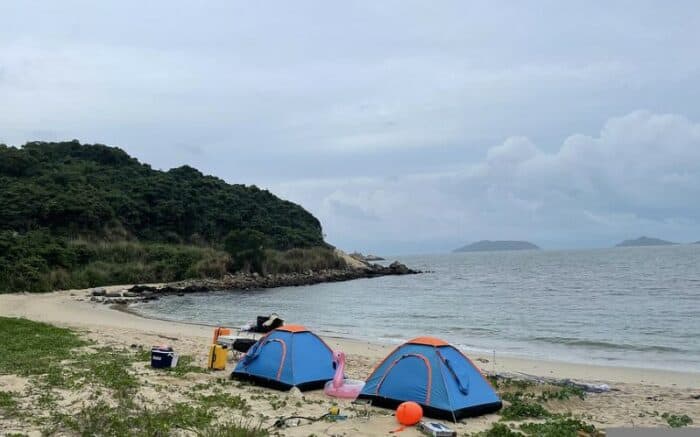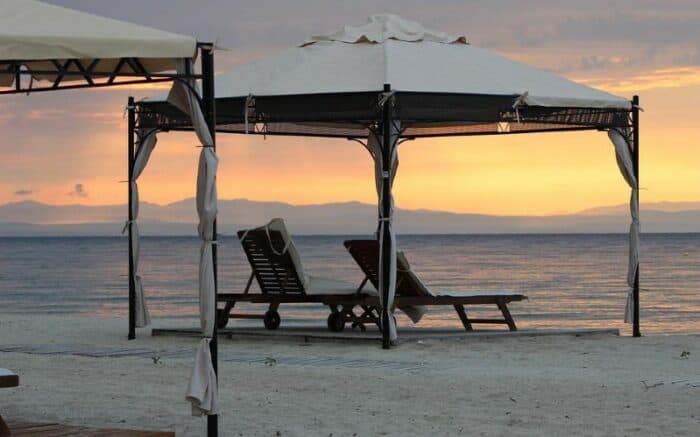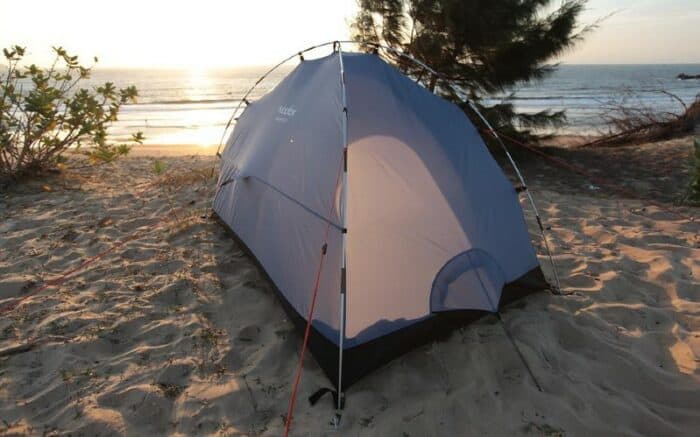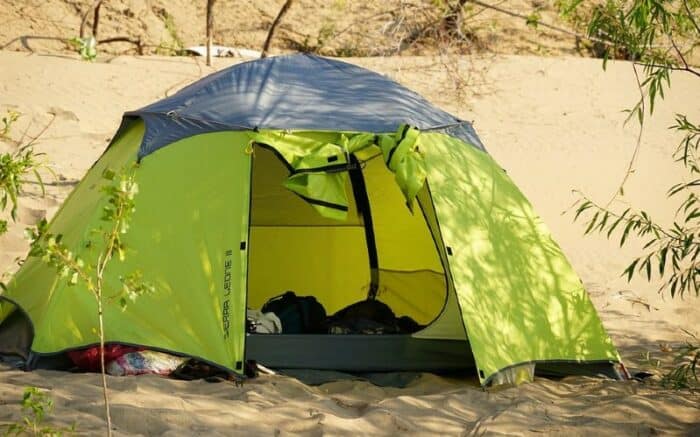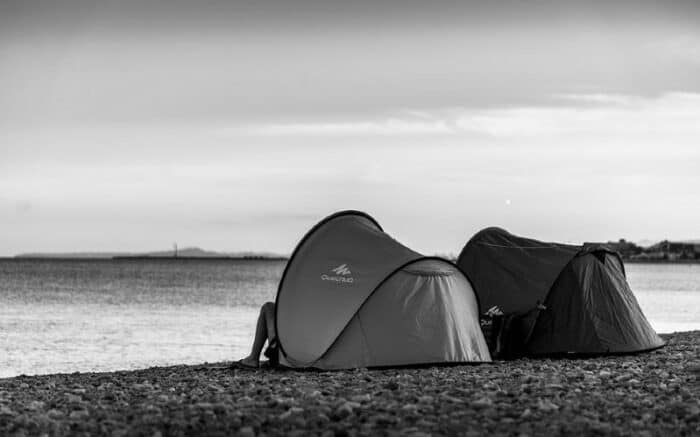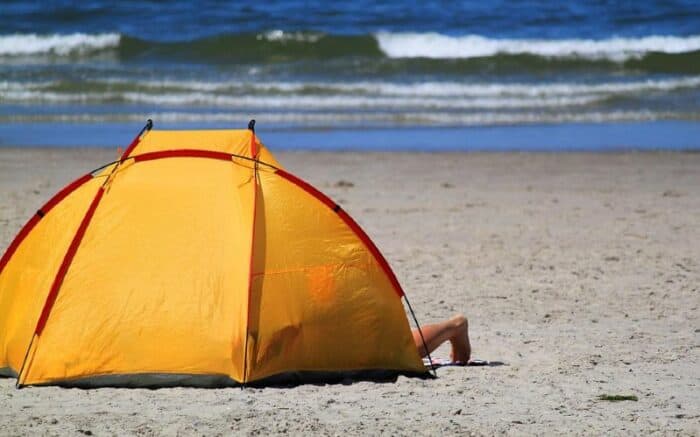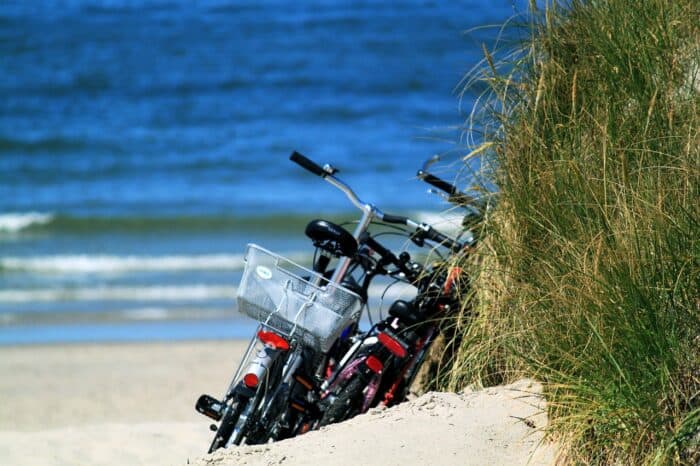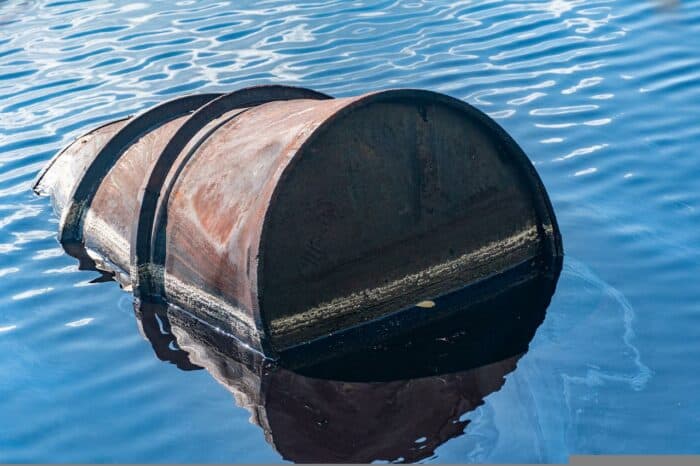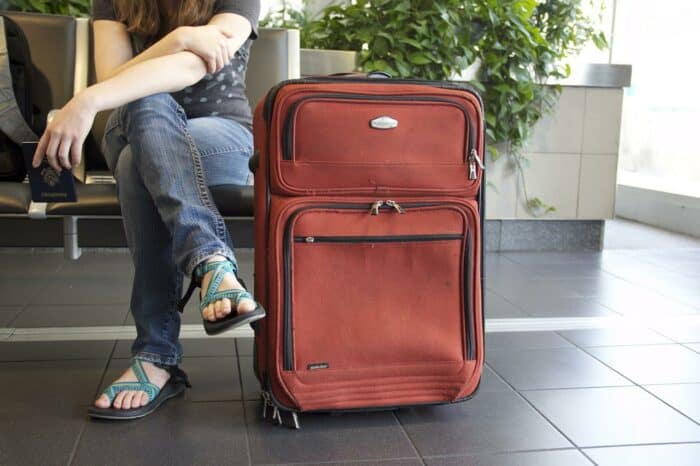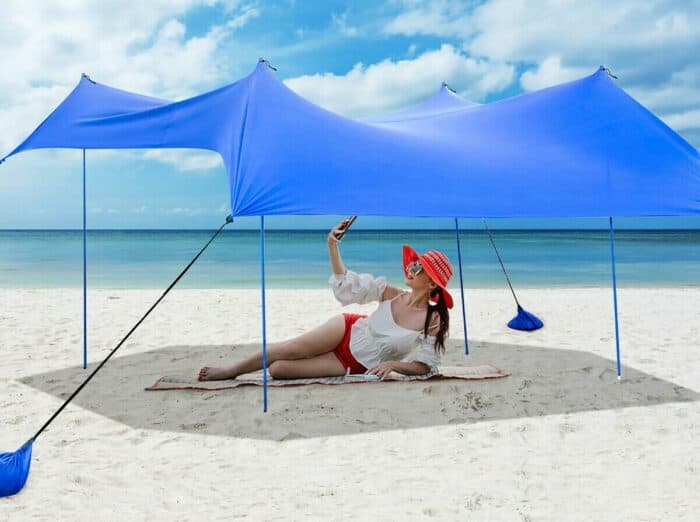How to Set Up a Tent on the Beach
If you’ve ever gone camping with an old pro before, no doubt you’ve watched them get a tent set up in mere minutes. Some people are just amazing at pitching tents. But for the rest of us, it can be a little trying at times. And on the beach it can be even worse. Wind and sand are much worse on a beach than camping. So while you may have your favorite beach towel laid out on a beach chair with some drinks and the cooler, the tent can be a bit more of a chore.
Luckily, setting up a tent on a beach doesn’t need to be a hassle. We have some tricks and tips to ensure you’ll be made in the shade in no time.
Can You Have a Tent on the Beach?
When it comes to the question of whether you can actually have a tent on the beach there are usually two kinds of people. Those who seek to find the answer and those who just put their tent up, anyway.
In terms of is it allowed? Most beaches are open to his sort of thing. But can you in the sense of is it possible? That can be a little harder thanks to the environment. But not impossible. So, to answer your question, yes, you can have a tent on the beach. Just be prepared to put a little more effort into setting it up than a traditional tent.
Beach Tent vs Traditional Tent
Most people who use a tent on the beach actually just use a pop up tent or a beach canopy. These just offer temporary shade. But there are larger beach tents and there’s no reason you can’t set up a regular camping tent on the beach, either. If you want to spend the night in front of the surf you’ll want a “real” tent to sleep in.
If you’re just setting up for the day on a beach with a lot of people, I recommend using a canopy or pop up tent. They’re faster to set up and they are designed for use on the beach. That means they were made with sand and wind in mind, so they have features to accommodate that. Plus, pop up tents are smaller and that’s just a point of consideration. No doubt you’d been to a very crowded beach in the past where space is at a premium. Other people don’t want your tent in their way almost as much as you don’t want other people getting close to your tent. These smaller beach tents make it easier to use less space and stay out of the way while still enjoy shade and privacy.
How to Set Up Beach Tents for Beach Camping
The big issue with setting up a tent on a beach versus literally anywhere else is the ground. Sand is a very poor base for anything to be set up on and that’s what you’re working against. The other thing is that a beach, by definition, is very open. That means nothing stops the wind and that can wreak havoc on any tent. If you don’t stake your tent out well, you’ll be on lumpy, shifting ground and it will blow over when you least expect it.
Choose Your Site
If you plan to spend the night in the tent and not just a few hours on the beach, this is more important. You want to find a spot that is smooth and even and away from any sharp rocks. If you can find a place near rocks, that could be helpful if you plan on rock stacking, which we’ll explain shortly. That aside, location on a beach is usually open to your personal likes. Just make sure you’re not too close to the incoming tide.
Set Up
If it’s a calm and still day, you may be able to manage this well enough by yourself. If it’s already windy, having a friend help you set up a tent on a beach can go a long way. One of you can hold the tent poles while the other secures things in place. That will go a long way to preventing the wind from foiling your tent before you’ve even got it up.
If you’re doing the job solo, just make sure you’re keeping things even. Distribute weight evenly to the corners and weight things down as you work so nothing blows away or folds over. Secure your tent to the frame, get the poles attached and go corner to corner getting things set up while you keep the ones waiting for you weighted so they don’t fly off unexpectedly.
You can dig holes for the anchors or stakes to sit in if you’re doing this alone as well. Dig a small hole at each corner, place your sandbags, rocks, or just sand from the holes at each corner to keep them in place until you have all the canopy poles in place in the frame. Then you should be able to carefully raise the tent in the center. This very much depends on the style of tent you’re raising, of course. Larger tents are more cumbersome and it may take a little extra work to perfect this step.
Sand Anchors vs Tent Pegs
Your tent, if it’s just a regular tent not specifically for beach use, probably has normal tent stakes. Normal stakes are usually long, thing metal or plastic stakes with a hook on the end to attach the tent. They are mostly useless in sand, however.
On normal soil they grip because the earth is tightly packed so that when you hammer them in, they are wedged in place by the force of the tightly packed soil pushing back on them. It’s the same principle as putting a nail into wood. But try to put a nail into sand and what happens? A whole lot of nothing. Same with those tent pegs.
Beach tents need anchors to be properly secured. You can get a couple of kinds of anchors. Some tents use sand bags. These are weighted anchors that use the mass of the sand inside to hold the tent in place. Other anchors are like corkscrews and can be screwed down through loose sand to the firmer, wetter sand down below. The threads on the screw offer more support and prevent the stakes from pulling out easily.
Anchor Alternatives
Let’s say you don’t have sand anchors handy. Or maybe the sand is really deep because you’re in a desert area and you just can’t get any purchase with a screw-down anchor. There are still solutions you can try. The first is essentially a sandbag anchor substitute. If you don’t have these weighted anchors that you can fill on site, try rock stacking.
Rock stacking makes use of the natural terrain and features to keep your tent staked out. As long as there are rocks near your campsite, this can work. Basically you set up your tent as normal and then gather rocks to weigh down the corners in place of sandbags or stakes.
You need large, flat rocks for this to work effectively. Set the rock away from the corner of the tent where you would place your stake and run a guyline over the rock. Attach it to the stake on the far side of the rock, away from the tent, and sink it into the sand as well as you can. Now stack a few more rocks, which can be smaller but bigger and heavier will always be better. On top of the stake and your flat rock. You’ve weighted and wedged your stake in place with the rocks. Do this at all four corners or wherever guy lines are going to be attached.
When it comes to the number of rocks, more is always better. They’re just rocks, no need to be sparing with them.
So what if you’re on a beach with no large rocks anywhere nearby? Use a deadman anchor. Not only is the name cool, it’s incredibly effective. But it’s a little time consuming and you’re going to want to have a shovel to get it done.
To do a deadman anchor you need to dig a hole. This should be at least a foot deep. You want to get below all the very loose sand into the firmer stuff. Once down there, use one of your normal tent pegs or, if you have none, some kind of a stick or anything else that will serve as a stake. Anchor your tent down in the hole and then fill the whole in again. The weight of the sand on top is going to keep that stake very secure no matter how bad the wind gets. Just make sure you buried it deep enough. If the sand is still loose even one foot down, it may be a little less secure.
Ideally you can place a rock on top of the sand because, if the sand is still loose, it can pull away in a stiff wind.
Beach Tent Guy Lines
Securing tents with guy lines is important. But if you can swap in some longer, better quality line it will be worth it. Get a good quality, non-slip guyline that’s a nice, highly visible color so you don’t have to search for them once the sun starts going down. A 1.5 mm guyline is a good size to get and make sure it’s durable. Dual weave polyester at that size will have a 400lb test strength. That ought to hold any tent under normal and even very windy conditions. You’ll want your guylines in 3” lengths to do the best job in sandy, windy conditions.
Using a durable polyester line is very important if you plan to use rocks as anchors, as well. With the wind blowing, the lines will rub against those rocks and you don’t want them to fray.
Remember to keep your guylines nice and taught. A guy line that is loose and has slack is not doing anything so it won’t secure your tent.
Beach Tent Tips
If you’ve never camped on a beach before this will sound weird, but bring a doormat. If you have camped on the beach you know what I’m saying. The sand is annoying. It’s really annoying. But a doormat outside of the entrance can make a real difference. Something sturdy that will take off most of the sand as you’re on your way in and also serve as a block to sand that the wind blows towards the entrance. Keep in mind, no matter what, you’ll still get plenty of sand in the tent anyway. But this will cut back on it significantly.
Wind direction can change out of the blue, but try to keep your tent door out of it. Set it up so the wind is hitting the side of your tent to avoid a lot of billowing and shaking.
Does Tent Fabric Make a Difference?
This speaks again to what you want to do on the beach in your tent. Beach tents are traditionally made from very thin material and are light weight. Their job is to protect you from the sun and, to some extent, wind. They’re small and lightweight and not meant to keep you protected during rain or overnight.
Camping tents are made of thicker fabrics, including canvas. They may not be as easy to assemble but they’re designed for more comfort and more space so they take more work. Both can work great, you just need to make sure you’re putting them up the right away.
Heavier tents will need more prep and more stability on the beach. A light breeze is less likely to rattle a camping tent than it will a pop up tent or canopy. However, a stiff wind could collapse it under its own weight if it’s not put up right, while a canopy will withstand it because the wind goes right through. So it’s a bit of a balancing act to get things working right.
If you have a thicker fabric in your tent, you may need to have all those vents and windows open to allow airflow. This prevents the wind from getting inside and basically turning your tent into a parachute. If the air can pass through, the tent will shake but it won’t be as likely to pull right out of the ground.
Those lighter tents may be able to handle the wind to some degree but they offer less room and less protection, especially if you plan to sleep in one. If you’re on a day trip I definitely recommend a light pop up tent or canopy. If you’re sleeping, I recommend a regular tent for sure.
Advantages of a Camping Tent Over a Beach Tent
Like I said, if you’re spending an afternoon on the beach and want some shade, a beach tent is great. But, at the end of the day, it’s basically just a more elaborate beach umbrella. It’s not meant for camping. So let’s look at why you might want a true camping tent for your time on the beach.
- Camping tents have a lot more room. Because a beach tent isn’t designed for sleeping it likely won’t have the extra space you want. Some beach tents can be quite large, of course, but in general most camping tents are larger.
- Camping tents have better protection from the elements. This is where things can get a little tricky. On a really hot day with no wind, a camping tent may become unbearable. It can get hot inside and, with no airflow, it can be really uncomfortable. A beach tent or canopy will be more open so, even if there’s no breeze, it won’t feel as hot. But you need to consider the opposite. If it gets windy or if it rains suddenly, you’ll be much happier and more comfortable in a true camping tent as a result. If you want to sleep overnight, you really do need a true tent.
- Camping tents offer a lot more privacy than beach tents. They’re not meant to be open and flimsy so that means you can get in there and have a nap or even change if you want to.
- Camping tents are also more versatile. If you’ve gone shopping for beach tents you’ll see that, while there are many brands available, they don’t offer a ton of different features, shapes and sizes. Camping tents, because they are so much more popular, come with nearly endless options. You can get camping tents to fit over a dozen people. You can get them with separate rooms inside, and windows, and storage areas, and so much more. They may cost more, but you can get a lot of good value, too.
Can I Spend the Night on the Beach?
This is a tough question to answer because it’s impossible to answer. Different beaches have different rules. You’ll need to check with the local by-laws of whatever beach community you’re heading to if you want to find out for sure. Some beaches absolutely allow it, some shut down at a certain time of night and no one is permitted.
Many popular beaches have camping areas that are specified, so you may not be able to set up your tent where everyone is playing and swimming, but at a place further up the beach.
The Bottom Line
Setting up a beach shelter doesn’t have to be difficult, it just requires some planning. The wind and the sand are never impossible to overcome. Choose your tent based on what you need – a quick afternoon out of the sun or a place to spend the night. Make sure you have those corners and guy lines secured so that the wind can’t take your tent for a trip and everything should be fine. As always, stay safe and have fun.
Categories: Beach
